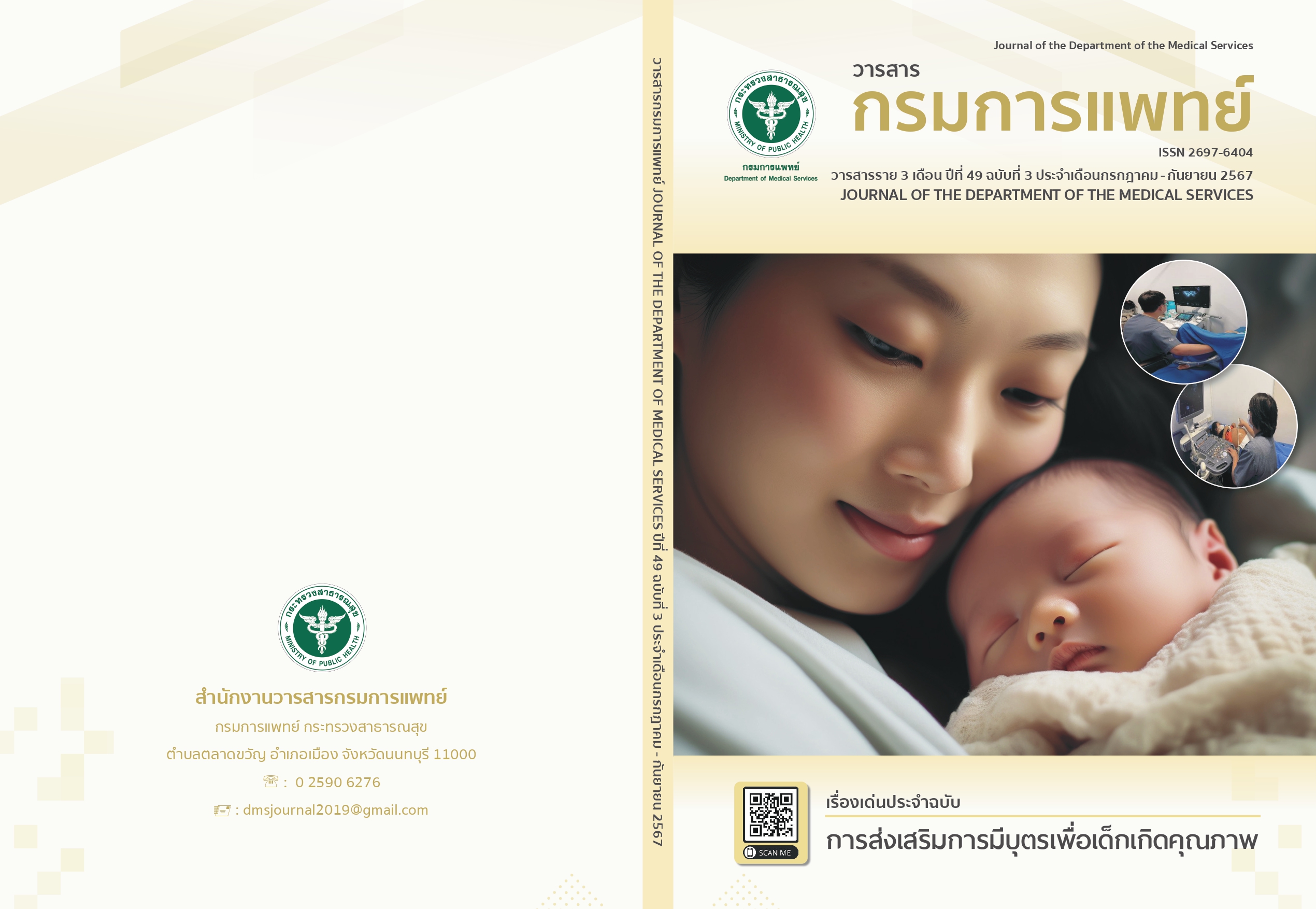Caring for an End-of-life Cancer patient with Pressure Sores Receiving Continuing Care at Home with the Caregiver’s Participation through the Tele-nursing System: A Case Report
Keywords:
End-of-life, Pressure sores, Caregivers, Tele-nursingAbstract
Pressure sores that are large and deep in the muscles among end-of-life cancer patients can cause risk of infection and death in a short time. Suffering also affects quality of life and results in higher costs because the treatment is complicated. Continuing care at home by caregivers also requires the assistance of a multidisciplinary team. This study aimed to investigate the efficiency of pressure ulcer care by a caregiver, provide guidelines for preventing infection, compare costs and the caregiver’s state of distress. A patient with end-of-life cancer with large pressure sores (the PPS level = 20%) was studied. The study was conducted between 1st September and 10th November 2023 by a multidisciplinary team, consisting of doctors, community practice nurses, and nurses specializing in nutritional therapy and wounds. The Tele-nursing system was employed. The tools included the PUSH assessment form (3.0), the temperature recording form, the wound dressing cost comparison form, the distress thermometer, the 2Q depression screening form, and the care burden assessment form. This study is results revealed that the caregiver was able to care for the patient according to standard quality. The wound healing score decreased from 14 points to 3 points. Infection was not found. It can save costs by 4.6 times compared to hospital stays. The caregiver’s distress score decreased from 9 points to 4 points on the distress thermometer. The caregiver was confident and proud of providing better care to the patient. To sum up, large pressure sores can be cared at home by caregivers, but the knowledge about wound dressings, wound healing promotion, nutrition, use of medical supplies to accelerate tissue regeneration, infection prevention and control and close supervision is required in helping caregivers to administer wound dressings effectively.
References
Ministry of Public Health. Department of Medical Services. National cancer control programme 2018-2022. Nonthaburi: Department of Medical Services; 2018.
Nursing Division, Office of the Permanent Secretary Ministry of Public Health. [internet]. 2019. [cited 2019 Oct 05]. Available from: http://www.nursing.go.th. Thai.
VanGilder C, Amlung S, Harrison P, Meyer S. Results of the 2008-2009 International Pressure Ulcer Prevalence Survey and a 3-year, acute care, unit-specific analysis. Ostomy Wound Manage 2009;55(11):39-45.
Limrat N, Pairojkul S. End-of-life care for care givers. Khon Kaen: Klungnana; 2016
Semsarn S, Chaiviboontham S. A case study of palliative nursing care for persons with advanced lung cancer: Roles of advanced practice nurse. Rama Nurs J 2017;23(1):11-26.
Baumgarten M, Margolis D, Berlin JA, Strom BL, Garino J, Kagan SH, et al. Risk factors for pressure ulcers among elderly hip fracture patients. Wound Repair Regen 2003;11(2):96-103.
Lima AR, Palmer CR, Nogueira PC. Risk factors and preventive interventions for pressure injuries in cancer patients. ESTIMA 2021;19:e1021.
Kanwal F, Butt AJ, Hafeez H, Nasir KS, Batool S, Munawar M, et al. Reduction of home acquired pressure ulcers among palliative patients using quality tools and techniques. Clin Med (Lond) 2022;22(Suppl 4):92-3.
Jakobsen TBT, Pittureri C, Seganti P, Borissova E, Balzani I, Fabbri S, et al. Incidence and prevalence of pressure ulcers in cancer patients admitted to hospice: a multicentre prospective cohort study. Int Wound J 2020;17(3):641-9.
Ferris A, Price A, Harding K. Pressure ulcers in patients receiving palliative care: a systematic review. Palliat Med 2019;33(7):770-82.
Kocaman B, Akgöl V. Design and control of patient bed for prevention pressure ulcers in long-term inpatients. DUJE 2021;12(5):719-28.
Koller A, Miaskowski C, Geest S, Opitz O, Spichiger E. Result of a randomized controlled pilot study of a self-management intervention for cancer pain. Eur J Oncol Nurs 2013;17(3):284-91.
Edsberg LE, Black JM, Goldberg M, McNichol L, Moore L, Sieggreen M. Revised national pressure ulcer advisory panel pressure injury staging system: revised pressure injury staging system. J Wound Ostomy Continence Nurs 2016;43(6):585-97.
Pumraya P. Scales for assessment of pressure ulcer healing. J Thai Nurse midwife Counc 2009;24(3):20-30.
Channgam S. Construction of nursing standard for family caregiver preparation for home health care in patients with pressure sore [Thesis]. Chonburi: Burapha University; 2007.
Mamom J, Chansawat S, Niemrit S, Baikrut P. Effect of wound care skills model to promote wound healingin patients with pressure ulcers. TSTJ 2013;21(7):609-19.
Braga IA, Pirett CC, Ribas RM, Gontijo Filho PP, Diogo Filho A. Bacterial colonization of pressure ulcers: assessment of risk for bloodstream infection and impact on patient outcomes. J Hosp Infect 2013;83(4):314-20.
Pisuthigoson M. Using Palliative Performance Scale (PPS) to predict survival lengths of palliative care patients with and without cancer. UDHHOSM J 2019;27(3):294-302.
Usahapiriyakul S, Changmai S. Prevention of pressure ulcers in dependent elderly people at risk with caregivers’ participation in care. APHEIT Journal of Nursing and Health 2020;3(1):1-15.
Boonyoung S, Wisai K. Palliative Outcome Score, Stress and Depression of The Caregivers after Implemented Home-Based Palliative Care Guideline among Terminally Ill Patients of Primary Care Network, Phrao District, Chiang Mai Province. LPHJ 2020;16(2):104-17
Downloads
Published
How to Cite
Issue
Section
License
Copyright (c) 2024 Department of Medical Services, Ministry of Public Health

This work is licensed under a Creative Commons Attribution-NonCommercial-NoDerivatives 4.0 International License.
บทความที่ได้รับการตีพิมพ์เป็นลิขสิทธิ์ของกรมการแพทย์ กระทรวงสาธารณสุข
ข้อความและข้อคิดเห็นต่างๆ เป็นของผู้เขียนบทความ ไม่ใช่ความเห็นของกองบรรณาธิการหรือของวารสารกรมการแพทย์


